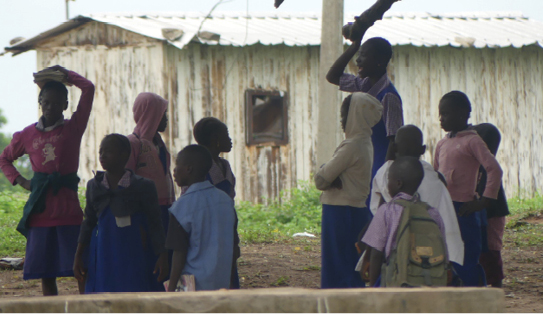Children under the radar: Unseen and vulnerable
Ruth was 13 years old when it happened. She was seated beside her sister when her sister took the call. Her sister wailed, went limp, then got very agitated. Other passengers anxiously turned toward her in obvious question to ask what happened. “My papa don go,” she wailed. Her voice shook. Tears streamed down her […]

Caption Children in congress after a busy school day in Paikon Kore, Gwagwalada. Vulnerable children may never get any access to education.
Ruth was 13 years old when it happened. She was seated beside her sister when her sister took the call. Her sister wailed, went limp, then got very agitated.
Other passengers anxiously turned toward her in obvious question to ask what happened.
“My papa don go,” she wailed. Her voice shook. Tears streamed down her face.
Ruth began to cry too. Their mother had died four years earlier. She was officially an orphan and vulnerable.
The numbers of vulnerable children—including orphans—are increasing across the country. And many are going under the radar, unseen, unheard, unnoticed.
Authorities officially define them as being under 18 years old, and, most importantly, “currently at risk of lacking adequate care and protection”.
“Also considered vulnerable are children whose parents do not have the capacity to care for them,” says Aloysius Ebedi.
The lack of capacity could be due to health, physical, social or economic reasons.
Across the world, up to 143 million children have had at least one parent dead. The highest proportion—72 million—is recorded in South East Asia.
Data available on child protection also indicate a rising number of orphans—12 in every 100 children in Africa orphaned going back to 2010.
In Nigeria, that amounts to 17.5 million orphans and vulnerable children (OVCs), with 7.3 million of them losing a parent or both to HIV alone.
Data shows the rising trend over years.
The numbers of orphans and vulnerable children has steadily risen from 8.2 million in 1990 to 9.7 million in 2000. It climbed to 12 million by 2009.
Vulnerability increases with the death of one parent, when children are abandoned by parents, live in extreme poverty, live with a disability or are affected by conflict.
One in every four children aged under 18 is vulnerable. Another found that one in every four orphans and vulnerable children in Nigeria showed mild to moderate malnutrition. And seven in 10 of them experienced “household food insecurity”—in other words, they didn’t get enough food to sustain themselves.
That extends to health care for vulnerable children, says Benjamin Odeka, of Lady Helen Child Health Foundation.
The foundation started a patient treatment assistance programme which seeks out vulnerable children after its survey found children seeking treatment in hospital and unable to pay.
“Some children go to hospital for treatment. At the end of treatment, they can’t pay and the hospital doesn’t want to discharge them. I cannot understand that,” he says.
Child agencies like UNICEF advocate child health policies to include protection for children in humanitarian settings, on camps for displaced people and in zones of insecurity.
The Child Rights Act creates “a window of opportunity” to reconsider the plight of vulnerable children—and requires each state to adopt it. But 11 states are yet to domesticate the Act.
“Health in the concurrent list makes it difficult for the national (government) to implement (the Act) in states,” explains Tinu Taylor, deputy director of the Child Survival Unit at the federal health ministry.
Orphans and vulnerable children may live in orphanages or on the streets. Or with extended families—but that itself comes with its challenges, says Ebedi.
“It is customary in Nigeria for extended family to care for orphans and vulnerable children,” he says.
Like Ruth. Without parents, she and her sister were bumped from place to place. By 15, she fell pregnant. Now 17, makes a living waiting tables at a restaurant in Mararaba, while her two-year-old daughter tags along.
Source of data: Federal Ministry of Health (FMoH).
